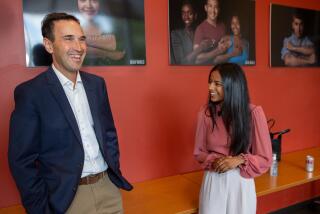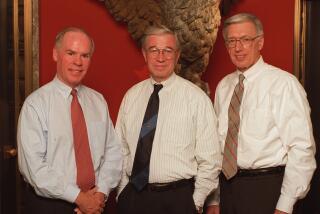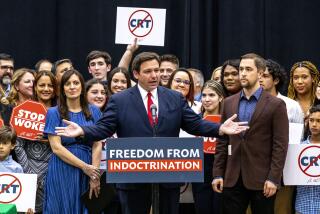John Marburger III dies at 70; science advisor to President George W. Bush
Physicist John H. Marburger III, who served as President George W. Bush’s science advisor at a time when most researchers considered science to be under attack by the government, died July 28 at his home in Port Jefferson, N.Y. He was 70 and had non-Hodgkins lymphoma.
He also served as dean of USC’s College of Letters, Arts and Sciences, as president of State University of New York at Stony Brook and as head of Brookhaven National Laboratory on Long Island.
“Jack Marburger was a superb advocate for science, a visionary leader, and a highly skilled administrator who successfully led three vital institutions,” said Dr. Samuel L. Stanley Jr., the current president of Stony Brook. “He was a man of extraordinary energy, a man who loved solving problems both scientific and administrative, a man of action, who was also thoughtful, contemplative and very strategic.”
When Marburger took office as science advisor and head of the White House Office of Science and Technology Policy in September 2001, the eight-month-old Bush administration was already being attacked as anti-science. The executive branch installed new rules sharply limiting the use of fetal stem cells in research and called into question much of the science relating to global warming. Critics charged that the administration also disbanded or stacked scientific advisory committees to reflect its own political goals rather than to seek scientific truth.
Marburger, a lifelong Democrat, was forced to defend those positions, which caused at least one scientist, Harvard psychologist Howard Gardner, to say, “I think he probably is enough of a scientist to realize that he basically has become a prostitute.”
Most researchers, however, continued to hold great respect for Marburger and the even-handed way he managed his duties. Physicist Lewis M. Branscomb, a former head of the National Bureau of Standards and a member of advisory committees for four presidents, commiserated with Marburger’s difficulties.
“I have a great deal of sympathy for his position, because I don’t believe he has the authority, the power, to go back to the agencies and unearth all the facts about all these cases,” Branscomb said.
Marburger repeatedly made it clear that it was his job to offer the best possible advice to the president and to promote the administration’s policies, whether he agreed with them or not.
“No one will know my personal positions on issues as long as I am in this job,” he said in 2004. “I am here to make sure the science input to policy making is sound and that the executive branch functions properly with respect to its science and technology missions.”
Perhaps his biggest misstep involved his response to a February 2004 open letter from 60 highly respected scientists, including 20 Nobel laureates. The letter argued that the Bush administration had shut down scientific advisory committees, stacked others with unqualified but politically correct appointees and censored reports that conflicted with the administration’s views.
Marburger was highly critical of the letter, arguing that there had been only a few such incidents that might have “ruffled feathers” and that the letter was a “conspiracy theory report.” Critics said he reacted much too hastily rather than promising to examine the issues raised by the scientists.
Bush released a statement last week calling Marburger “a joy to work with” and noting that “Jack was dedicated to his field, his family and his country.” As president, Bush was considered to be enamored of the clear, concise manner in which Marburger explained complicated concepts.
John Harmen Marburger III was born Feb. 8, 1941, on Staten Island and raised in Maryland. He received his bachelor’s degree in physics from Princeton University in 1962 and his doctorate from Stanford University in 1967. His primary field of research was on the interactions of laser light with matter, but his other activities ultimately left little time for research.
Upon his graduation, he joined the faculty of USC, becoming chairman of the physics department and ultimately rising to the position of dean. In 1980, he was brought in as president of Stony Brook, where severe budget cuts had been leading to wide declines in research. There, he brought in massive new federal funding and established a medical school and hospital.
In 1997, he helped the university gain a contract to run Brookhaven, and he was the natural choice to head it. He played a key role in establishing the Relativistic Heavy Ion Collider, a major accelerator, at the laboratory. After his stint in Washington, he returned to the lab, where he became vice president for research.
Marburger enjoyed gardening, music, reading, horseback riding and, especially, woodworking. He built a working harpsichord by hand.
He is survived by his wife of 46 years, the former Carol Preston Godfrey; two sons, John of Annandale, Va., and Alexander of Jamaica Plain, N.Y.; a grandson; and his sister, Mary Hoffman-Habig of Edgewater, Md.
More to Read
Start your day right
Sign up for Essential California for the L.A. Times biggest news, features and recommendations in your inbox six days a week.
You may occasionally receive promotional content from the Los Angeles Times.




















































